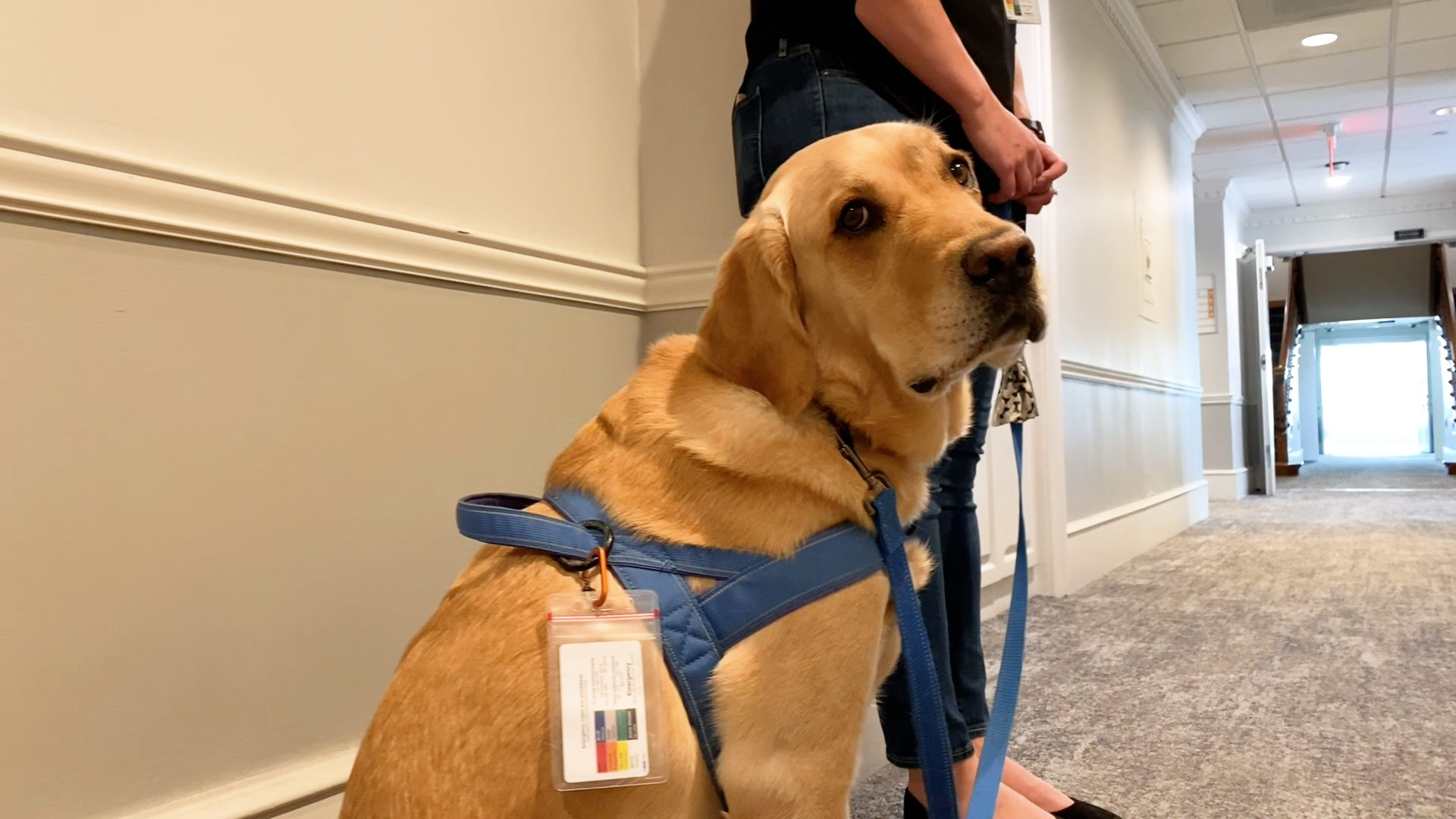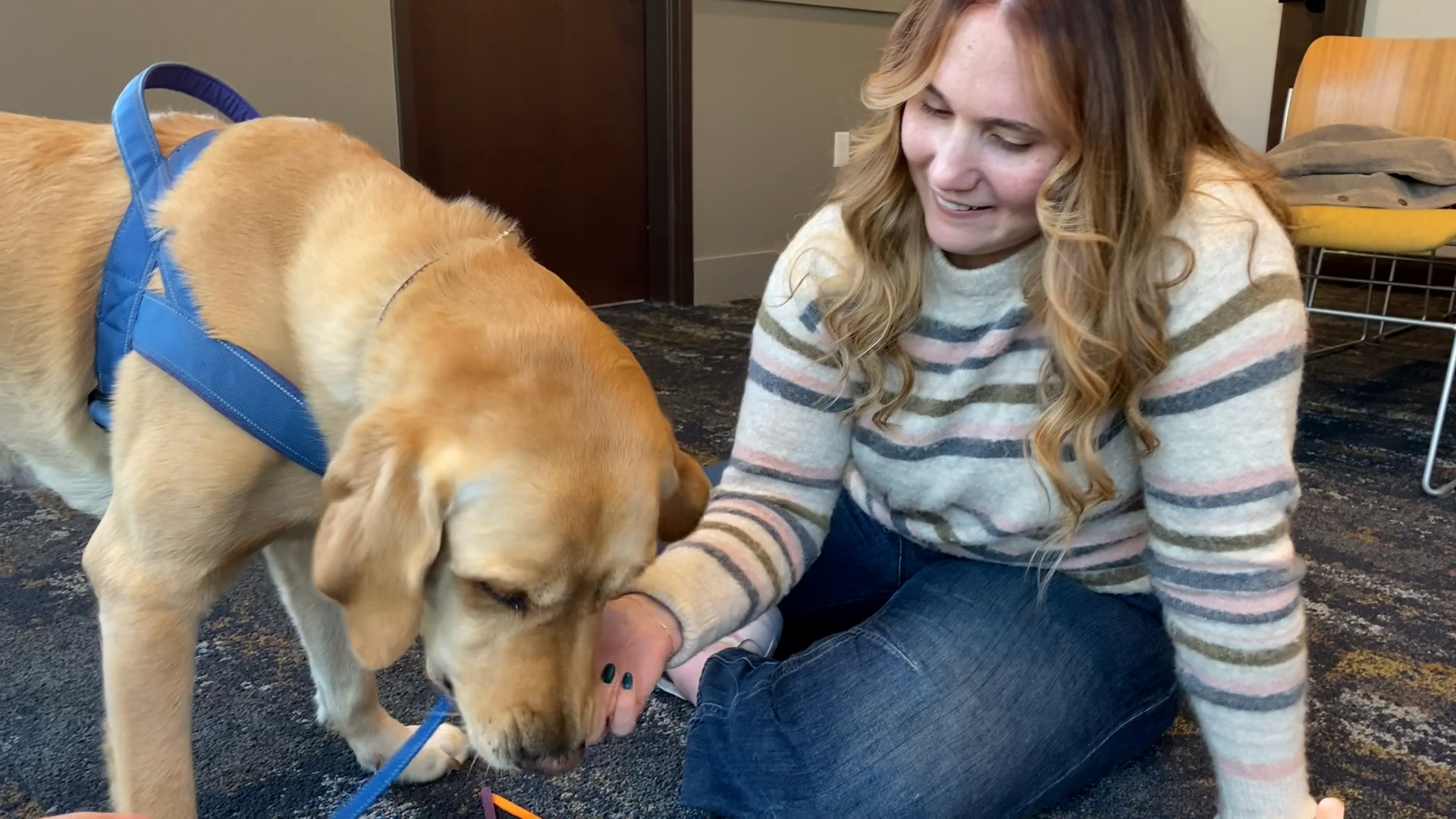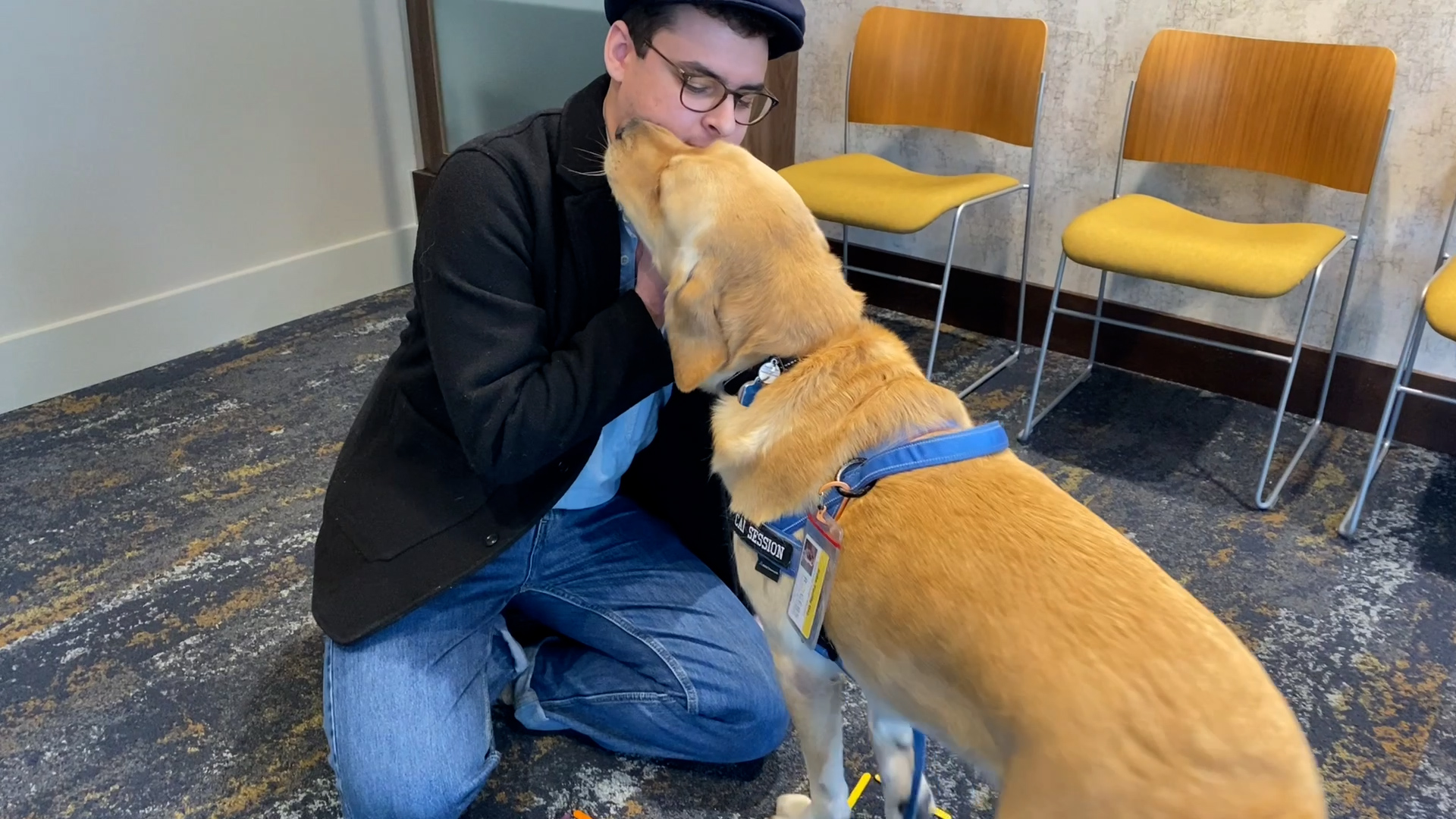By Deana Grall, Manager of Experiential Therapy at Rogers Behavioral Health
With a wagging tail and soulful eyes, Kobe—a 4-year-old Labrador/Golden Retriever mix—offers more than companionship at Rogers Behavioral Health. He’s a full-time experiential therapy assistant in Rogers’ Canine Assisted Intervention (CAI) program in Oconomowoc, Wisconsin, where he supports individuals navigating the challenges of OCD, anxiety, and depression while in residential treatment.
“Kobe isn’t a pet therapy dog,” explains Deana Grall, manager of experiential therapy and one of Kobe’s handlers. “He’s an active participant in goal-directed experiential therapy sessions.”

By engaging with patients, Kobe helps them achieve an identified treatment goal and strengthen their skills in assertiveness, self-confidence, motivation, self-care, and overcoming contamination-related challenges.
“I think of what the patient is working on, and which activity can help promote certain thoughts and feelings,” says Mariah Skindingsrude, experiential therapist, and Kobe’s primary handler. “Kobe provides non-judgmental support. I often see people leaving their comfort zone, building trust, and being more willing to open up and talk about difficult things.”
How it works
Patient care teams meet regularly to review treatment plans and discuss whether anyone might benefit from CAI sessions with Kobe. If deemed appropriate, an order is written, and specific treatment goals are defined. Upon the patient’s agreement and depending on Kobe’s availability, sessions are scheduled three times a week.
Before each CAI session, patients rate their anxiety, depression, suicidal ideation, self-harm urges, confidence, hope, and motivation for treatment using a seven-point scale. Additionally, they describe how they feel physically and emotionally. Following each session, they complete the same evaluation, while Mariah documents whether they achieved their goal and, if not, any challenges that prevented progress.
The clinical team partnered with Rogers Research Center and IT departments to create an objective session documentation in the electronic medical record with the goal of gathering data to evaluate CAI’s impact.
“We’re working to make this program more data-driven so we can better understand which patients benefit from it and how much,” says Dr. Kelly Piacsek, PhD, executive vice president of Research at Rogers.
Canine Assisted Intervention activities
Activities with Kobe can include, but are not limited to:
Exposures: Kobe carefully assists with exposing the patient to an object, activity, or situation that the patient has identified as evoking fear or avoidance. Over time, repeated exposures in a safe, secure environment help the patient reduce fear and decrease avoidance from the object, activity, or situation.
Puppy Painting: The patient is given a challenge that is reflective of their treatment and can be done on paper (identify 10 strengths or gratitude items, write out your values, etc.). Paint is applied to the back of the paper and the paper is then placed in a clear zip lock bag. The bag is sealed shut, and a treat is placed on the outside of the bag. When Kobe licks the treat off the bag, it smears the paint inside. The result is a “Kobe original painting” for the patient to keep, which also serves as a physical reminder of the items they wrote on the paper.
Walkabout: While on a walk with Kobe, the patient is encouraged to say hello to people passing by. If someone stops, the patient is responsible for answering questions about Kobe or holding a conversation.
Trick Training: The patient teaches Kobe a trick. During this process, it brings up discussions about the difficulty in learning new things, personal rewards, distractions, motivation changes, assertiveness practice, self-compassion, communication styles in general, dealing with uncertainty, and willfulness.
Mindfulness Activities: Activities include mindfulness walks on campus or utilizing the labyrinth to focus on grounding technics or mindfulness tools. Kobe participates in Progressive Muscle Relaxation “PMR” by laying on the floor with the patient as they engage. By placing a hand on him, it can be a simple reminder to remember to breathe through the exercise.
Doga: The patient does yoga with Kobe present, then reflects on healthy leisure, behavioral activation, mindfulness, self-care, motivational interviewing, expectations (did they expect Kobe to do the poses with them), and flexibility (pending patient).
Journaling: Kobe lays down next to people while they journal. Sometimes, the patient is instructed to journal via Kobe’s perspective. For example, “Journal about when Kobe had to leave his home in Michigan and become a Rogers’ employee!” It’s then used to discuss connections to patient treatment, encourage vulnerability, honesty with self, validate emotions, etc.
Dog Bowling: Bowling pins are set up with each pin representing a barrier, challenge, or something the patient doesn’t want. The patient then throws a tennis ball towards pins. Kobe runs after the ball but typically avoids knocking pins over. This promotes discussions on fear, how skills work best, asking for help, and so on.
Self-Care Lists: The patient writes a list of things they would do for Kobe to give him the best possible care, and then they make their own list. The patient identifies problem areas and how to improve them. Kobe helps by engaging in a task. For example, “I don’t like doing my laundry.” Kobe helps pick up the laundry and put it in the basket to wash or the patient creates “Kobe coping cards” to support in each situation.
“He’s been integral in our program,” says Sharon Hirsch, MD, adult, child, and adolescent psychiatrist at Rogers in Oconomowoc. “Giving Kobe commands builds confidence. We watch people regain the ability to function again, which is just so exciting.”

How Kobe came to Rogers
Made possible by Rogers Behavioral Health Foundation, Kobe came to Rogers two years ago from the Paws with a Cause (PAWS) custom training facility in Wayland, Michigan. PAWS has trained assistance dogs for 43 years, providing more than 3,000 dogs to people in 33 states. In 1986, PAWS helped create Assistance Dogs International (ADI), a worldwide coalition of organizations that train assistance dogs. They also establish standards of excellence used industry wide. Kobe completed PAWS’ foster puppy obedience and public access training, as well as advanced training in the PAWS Prison Partners Program. Upon returning from that program, he received an additional eight weeks of assessment and training to ensure he was ready to graduate. Kobe and Mariah are certified as a PAWS facility dog team.
“I see people connect with Kobe and build trust,” says Mariah. “He can be that breakthrough piece in someone’s treatment if they’re not progressing. He brings something to the table that we weren't able to do before he arrived.”
Click here to watch two former Rogers’ patients share how CAI played a meaningful role in their mental health journey.



Love reading this! It’s so important to add elements of life that make us happy and dogs are just the right fit. The impact they have is forever lasting. Keep up the great work!
I would love to know more about canine assisted ocd therapies in Phoenix,Arizona if any at all.
So happy to discover this recently added approach in assisting us OCD patients with improving & managing our struggles that our OCD enforces us to experience! I absolutely love all fur babies, so excited to try this approach! I’m definitely expecting numerous positive results…